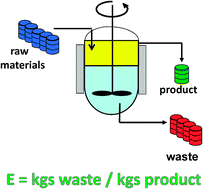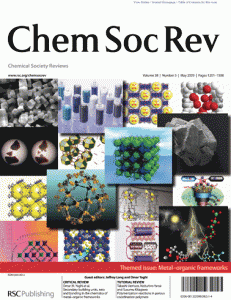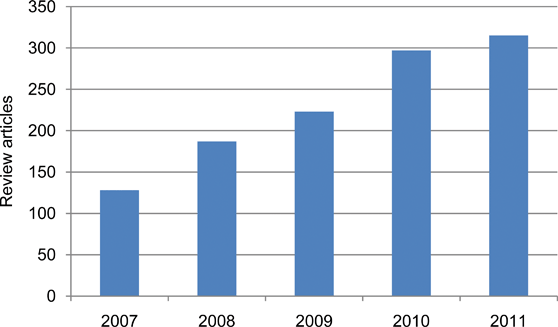This month sees the following articles in ChemSocRev that are in the top ten most accessed:-
Recent advances in cooperative ion pairing in asymmetric organocatalysis
Jean-François Brière, Sylvain Oudeyer, Vincent Dalla and Vincent Levacher
Chem. Soc. Rev., 2012, Advance Article, DOI: 10.1039/C1CS15200A
Green chemistry oriented organic synthesis in water
Marc-Olivier Simon and Chao-Jun Li
Chem. Soc. Rev., 2012, Advance Article, DOI: 10.1039/C1CS15222J
The golden age: gold nanoparticles for biomedicine
Erik C. Dreaden, Alaaldin M. Alkilany, Xiaohua Huang, Catherine J. Murphy and Mostafa A. El-Sayed
Chem. Soc. Rev., 2012, Advance Article, DOI: 10.1039/C1CS15237H
Palladium-catalysed cross-coupling of organosilicon reagents
Hannah F. Sore, Warren R. J. D. Galloway and David R. Spring
Chem. Soc. Rev., 2012, Advance Article, DOI: 10.1039/C1CS15181A
Chemistry and physics of a single atomic layer: strategies and challenges for functionalization of graphene and graphene-based materials
Liang Yan, Yue Bing Zheng, Feng Zhao, Shoujian Li, Xingfa Gao, Bingqian Xu, Paul S. Weiss and Yuliang Zhao
Chem. Soc. Rev., 2012, 41, 97-114, DOI: 10.1039/C1CS15193B
Anion receptor chemistry: highlights from 2010
Marco Wenzel, Jennifer R. Hiscock and Philip A. Gale
Chem. Soc. Rev., 2012, 41, 480-520, DOI: 10.1039/C1CS15257B
Mesoporous metal-organic framework materials
Weimin Xuan, Chengfeng Zhu, Yan Liu and Yong Cui
Chem. Soc. Rev., 2012, Advance Article, DOI: 10.1039/C1CS15196G
DNA in a modern world
Eugen Stulz, Guido Clever, Mitsuhiko Shionoya and Chengde Mao
Chem. Soc. Rev., 2011, 40, 5633-5635, DOI: 10.1039/C1CS90048J
Gold and iron oxide hybrid nanocomposite materials
Ken Cham-Fai Leung, Shouhu Xuan, Xiaoming Zhu, Dawei Wang, Chun-Pong Chak, Siu-Fung Lee, Watson K.-W. Ho and Berton C.-T. Chung
Chem. Soc. Rev., 2012, Advance Article, DOI: 10.1039/C1CS15213K
Great expectations: can artificial molecular machines deliver on their promise?
Ali Coskun, Michal Banaszak, R. Dean Astumian, J. Fraser Stoddart and Bartosz A. Grzybowski
Chem. Soc. Rev., 2012, 41, 19-30, DOI: 10.1039/C1CS15262A
Why not take a look at the articles today and blog your thoughts and comments below.
Fancy submitting an article to ChemSocRev? Then why not contact us today with your suggestions.
Comments Off on Top ten most accessed articles in November
![]() As of 2012, Chem Soc Rev now publishes 24 issues per year making us the most frequently published chemistry review journal.
As of 2012, Chem Soc Rev now publishes 24 issues per year making us the most frequently published chemistry review journal.











 Being ‘green’ is a concept that I think most people these days are familiar with. I was quite surprised to read in
Being ‘green’ is a concept that I think most people these days are familiar with. I was quite surprised to read in 







